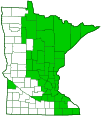common winterberry
(Ilex verticillata)
Conservation • Wetland • Description • Habitat • Ecology • Use • Distribution • Taxonomy
Description |
||
Common winterberry is a 5′ to 16½′ tall, slow growing, deciduous shrub that rises on multiple stems from a woody root system. It is native to North America east of the Great Plains. It is also cultivated as an ornamental. It is fairly common in the woodlands of eastern Minnesota. In wet areas it often forms dense colonies by sending up new stems (suckers) from root nodes. Stems are erect and up to 2″ in diameter at the base. The bark is thin, smooth, grayish-brown, and often mottled. First-year branches are slender, green, round, and usually hairless. Second-year branches are slender, smooth, and gray or grayish-brown. Mature branches and stems are grayish-brown and have numerous, scattered, pale, raised, horizontal, wart-like pores (lenticels). The pith is solid, not spongy, but it may be small and not easily seen. The buds are small and nearly globe-shaped. They have two or more bud scales. The bud scales are not tipped with a spine-like extension of the midrib (mucro). The leaf scars are small and are not raised or are only slightly raised. They have a single bundle scar. The leaves are alternate, relatively thin, 2″ to 4″ long, ¾″ to 1¾″ wide, and narrowly or broadly elliptic or egg-shaped. They are on ¼″ to ½″ long leaf stalks (petioles). The petioles are covered with short hairs. At the base of each petiole there is a pair of tiny, black, thorn-like appendages (stipules). The stipules may fall off early but are often persistent. The leaf blades are tapered at the base and short-tapered to a sharp point at the tip but do not have a spine-like extension of the midrib (mucro). The upper surface is green, dull, and hairless. The lower surface is paler and sparsely to moderately hairy at least along the veins. The veins are conspicuously depressed on the upper surface, conspicuously raised on the lower surface. The margins are finely toothed with sharp, spreading to forward pointing teeth. The inflorescence is small clusters of flowers rising from the leaf axils of first-year branches. Male (staminate) and female (pistillate) flowers are produced on separate plants. Occasionally, bisexual (perfect) flowers, with both male and female parts, are produced on an otherwise male or female plant. Staminate flowers are in clusters of 3 to 10 flowers on short, 1 ⁄32″ to 1 ⁄16″ long stalks (pedicels). There are 4 to 6 sepals and an equal number of petals and stamens. The sepals are tiny, about 1 ⁄32″ (0.7 to 1.4 mm) long, and have a fringe of hairs on the margin (ciliate). The petals are white to greenish-white, spreading with the tips sometimes bent backward, and 1 ⁄16″ to ⅛″ (1.5 to 2.5 mm) long. The stamens have white filaments and yellow anthers. Pistillate flowers are solitary or in clusters of 2 or 3 flowers. They are similar to male flowers but have 5 to 8 sepals and petals, and an equal number of sterile, modified stamens (staminodes). There is no style. The fruit is a bright red, globe-shaped, 3 ⁄16″ to 5 ⁄16″ (5 to 8 mm) in diameter, fleshy, berry-like drupe. The fruits mature in early September to early October and remain on the branch through winter and into the following spring. They are poisonous to humans but not to birds. |
||
Height |
||
5′ to 16½′ |
||
Flower Color |
||
White to greenish-white |
||
Similar Species |
||
|
||
Habitat |
||
Wet to moist. Forested wetlands, margins of ponds and marshes, lakeshores. Partial sun. |
||
Ecology |
||
Flowering |
||
Mid-June to early July |
||
Pests and Diseases |
||
|
||
Use |
||
|
||
Distribution |
||||
|
Sources |
|||
| 4/3/2023 | ||||
Nativity |
||||
Native |
||||
Occurrence |
||||
Fairly common |
||||
Taxonomy |
|||
| Kingdom | Plantae (green algae and land plants) | ||
| Subkingdom | Viridiplantae (green plants) | ||
| Infrakingdom | Streptophyta (land plants and green algae) | ||
| Superdivision | Embryophyta (land plants) | ||
| Division | Tracheophyta (vascular plants) | ||
| Subdivision | Spermatophytina (seed plants) | ||
| Class | Magnoliopsida (flowering plants) | ||
| Superorder | Asteranae | ||
Order |
Aquifoliales (hollies and allies) | ||
Family |
Aquifoliaceae (holly) | ||
Genus |
Ilex (hollies) | ||
Subordinate Taxa |
|||
|
|||
Synonyms |
|||
Ilex bronxensis Ilex fastigiata Ilex verticillata var. cyclophylla Ilex verticillata var. fastigiata Ilex verticillata var. padifolia Ilex verticillata var. tenuifolia |
|||
Common Names |
|||
black alder black-alder common winterberry Virginia winterberry winterberry winterberry holly |
|||
Glossary
Bundle scar
Tiny raised area within a leaf scar, formed from the broken end of a vascular bundle.
Calyx
The group of outer floral leaves (sepals) below the petals, occasionally forming a tube.
Drupe
A fleshy fruit with usually a single hard, stone-like core, like a cherry or peach; a stone fruit.
Filament
On plants: The thread-like stalk of a stamen which supports the anther. On Lepidoptera: One of a pair of long, thin, fleshy extensions extending from the thorax, and sometimes also from the abdomen, of a caterpillar.
Lenticel
A corky, round or stripe-like, usually raised, pore-like opening in bark that allows for gas exchange.
Pedicel
On plants: the stalk of a single flower in a cluster of flowers. On insects: the second segment of the antennae. On Hymenoptera and Araneae: the narrow stalk connecting the thorax to the abdomen: the preferred term is petiole.
Perfect
Referring to a flower that has both male and female reproductive organs.
Petiole
On plants: The stalk of a leaf blade or a compound leaf that attaches it to the stem. On ants and wasps: The constricted first one or two segments of the rear part of the body.
Pistillate
Referring to a flower that has a female reproductive organ (pistil) but does not have male reproductive organs (stamens).
Staminate
Referring to a flower that has a male reproductive organs (stamens) but does not have a female reproductive organ (pistil).
Staminode
A modified stamen that produces no pollen. It often has no anther. Plural: staminodia.
Stipule
A small, leaf-like, scale-like, glandular, or rarely spiny appendage found at the base of a leaf stalk, usually occurring in pairs and usually dropping soon.
Visitor Photos |
|||||
Share your photo of this plant. |
|||||
| This button not working for you? Simply email us at info@MinnesotaSeasons.com. Attach one or more photos and, if you like, a caption. |
|||||
Luciearl |
|||||
These are easily spotted at the end of Sept as other leaves start to drop off. |
|||||
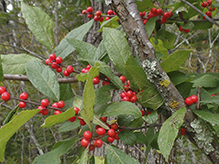 |
|||||
Kirk Nelson |
|||||
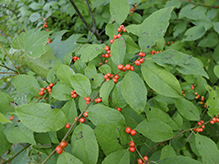 |
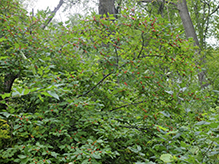 |
||||
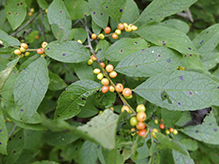 |
|||||
MinnesotaSeasons.com Photos |
|||||
Inflorescence |
|||||
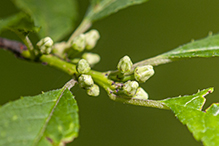 |
|||||
Leaf |
|||||
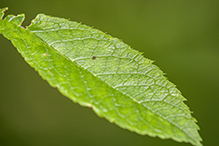 |
|||||

Visitor Videos |
|||
Share your video of this plant. |
|||
| This button not working for you? Simply email us at info@MinnesotaSeasons.com. Attach a video, a YouTube link, or a cloud storage link. |
|||
Other Videos |
|||
| Ilex verticillata (Winterberry) Northeastern native plant digest |
|||
About
Dec 12, 2018 Winterberry - A wonderful native shrub that's easy to grow and the birds will love. |
|||
| Ilex Verticillata Maria Galeano |
|||
About
Nov 28, 2018 |
|||

Created: 9/25/2019
Last Updated:
